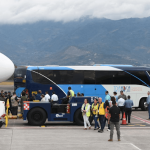
sikkim’s migrant workers describe perilous exodus to reunite with families
In the wake of a devastating flash flood in Sikkim, 59 migrant workers from various parts of India embarked on a perilous journey to safety. Their harrowing escape journey, facilitated by a Sikkim government bus, showcases their resilience in the face of a natural disaster.
Migrant Worker Shares His Jolting Experience of the Flash Flood:
On October 4, at 3 a.m., police sirens shattered the peace of the night, jolting Naresh Kumar from his slumber. He vividly remembers the fateful night when flash floods ravaged Sikkim, claiming at least 82 lives, and leaving around 140 people still missing.
Triggered by a glacial lake outburst in north Sikkim, a catastrophic flash flood surged down the Teesta River, wreaking havoc in its path. The aftermath was nothing short of devastating.
Fleeing to survive:
Faced with the impending disaster, Naresh Kumar, a migrant worker from Jammu and Kashmir, narrated his frantic escape. As a technician at NHPC India’s Teesta VI hydel power project, he was among those who witnessed the destructive force of
nature. He recounts, “We were told that a dam located upstream of the Teesta River had collapsed, and we must rush to safer places. I grabbed a bag and ran up the hill to save my life.”
A Perilous Journey to Siliguri:
Naresh Kumar was one of 59 migrant workers who embarked on a treacherous journey to reach safety. They spent ten hours on a Sikkim government bus, which followed an alternative route through Lava and Gorubathan in Kalimpong district to get to Bengal’s Siliguri town.
Keep Reading
A Narrow Escape:
Kumar reflects on their narrow opportunity window for survival, stating, “We had less than 15 minutes to save our lives. Had we not taken shelter in the hills, our names would have figured today on the list of the deceased or those still missing.”
A Glimpse of Hope for Migrants:
Agam Kumar, another technician from Bihar working on the same project, expressed gratitude for their miraculous survival. He shared how they managed to reach a shelter provided by NHPC and turned searchlights toward the river, witnessing the chaos below. “It was carrying away trucks that would have otherwise sunk. The vehicles looked like toys. We heard many people crying for help,” Kumar said.
Sikkim’s New Challenges:
The aftermath of the disaster brought new challenges to Sikkim. Severe shortages of essential commodities emerged due to collapsed roads and communication lines.
Gratitude and Solidarity:
As the migrant workers prepared to return home, Himmat Singh from Punjab acknowledged the gravity of the situation, saying, “The residential camp where I lived was washed away along with heavy engineering vehicles.” Despite the challenges, they thanked the government for providing free buses during this trying time.
The saga of these migrant workers highlights their resilience and the spirit of solidarity that emerged in the face of adversity. Their escape from the Sikkim floods is a testament to the strength of human survival and the importance of community support during times of crisis.









